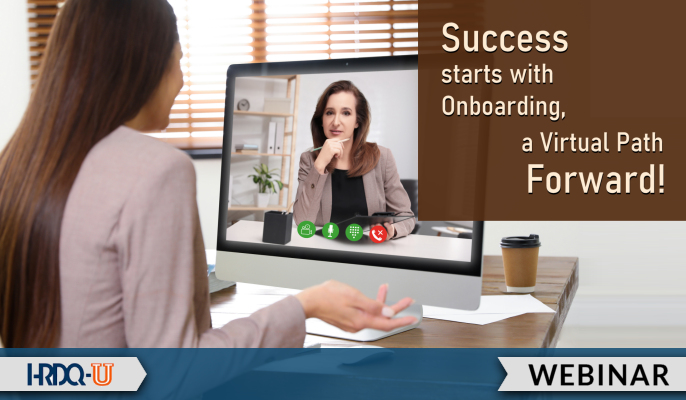- 827 Lincoln Ave. #B-10 West Chester, PA 19380
- support@hrdq.com
- +1-610-279-2002
Quick Links
Menu
Featured Topics
Menu
Total Results
We could not find what you're looking for. Please try again.No Record Found
Don’t miss this upcoming event from HRDQ-U

Remember your first day at the new job? Who knew there were so many benefit options? Do I put a 0 or a 1 on the tax forms? The video from the CEO was interesting, and lunch was nice, right? Nearly 50% of hourly workers leave within four months, and the same is true for senior leaders brought in – they leave in 18 months. As a leader, you want people to stay, so prepare them for success with a robust onboarding experience!
Onboarding in our hybrid workplace involves blending content resources and using virtual tools to create connections with teammates and business partners and includes learning scheduled in the workflow to meet the annual business lifecycle. A key component is creating a structured networking experience with others in similar roles to support performance and growth and developing the connections the new hire needs to be successful in their role. This model focuses on providing clarification of new responsibilities and expectations to new team members who won’t have experiences that leave them frustrated, confused, feeling alone, and unsure of their ability to be successful in this new role.
A structured onboarding program is key to long-term success and involves a strategic long-term plan. In this session, I will share a process that combines tactical training targeted around the needs of the role using the 4 “C’s” +1 model that centers on constant communication, feedback, and performance measurement – all factors that impact employee retention and engagement. We’ll explore the employee lifecycle for mentoring and development and how connecting people together builds the internal network and supports collaboration. Onboarding is more than a one-and-done session; it’s a process that prepares people to be successful for long-term performance.
This live event is free. A recording will be available after the event with an HRDQ-U Membership for Learning Professionals.


Ryan Consulting helps organizations develop high-performing people with learning and performance solutions that align with their goals. We focus on enhancing engagement and retention by improving people, processes, and platforms that shape the business culture and improve business results.
We start by defining what success looks like for your organization and how we’ll measure it. Then, we’ll dive deep into your current processes and future growth plans to identify opportunities for strategically integrating learning into key workflows. This will support and enhance individual performance. The end result? A strategic roadmap that meets your immediate needs while also planning for future talent development – all built on a foundation of accountability and a well-defined people strategy centered on achieving business results.
Email Bill at bill@williamjryan.com and mention HRDQ-U for a free 1-hour consultation.
William J. Ryan, Ph.D., is the Founder and Principal Consultant with Ryan Consulting, LLC, using learning as a strategic business tool to develop and impact people to improve retention, engagement, and performance. Bill has a demonstrated record of corporate and industrial management experience leading performance support and instructional design teams globally, including government (Dept. of Energy), high technology (IBM and Westinghouse), and health-related industries, including home healthcare and insurance companies (Humana). Recent client work included developing a strategy on a page (SOAP) as well as a leadership development plan for a national financial firm, a comprehensive talent staffing and development plan for a manufacturing concern, an implementation strategy for a hiring for competency model used by the National Retail Services, and a state initiative focused on workforce development, helping businesses retain and develop employees. Additional work has supported a clinical start-up focused on improved neonatal techniques for clinicians across the country and a blended leadership and coaching program for a multi-state manufacturing concern. Bill holds an MS from Ithaca College focused on instructional design and a Ph.D. in computing technology in education from Nova Southeastern University.
For more information, please visit his website at www.williamjryan.com or contact him via email at bill@williamjryan.com or by phone at (502) 797-2479.
Training Tools for Developing Great People Skills
This event is sponsored by HRDQ. For 45 years HRDQ has provided research-based, off-the-shelf soft-skills training resources for classroom, virtual, and online training. From assessments and workshops to experiential hands-on games, HRDQ helps organizations improve performance, increase job satisfaction, and more.
Learn more at HRDQstore.com

“This webinar was on target and provided great information. The presenter, Bill Ryan was very good, and kept my interest. The pace was perfect.”
Pam P.
Trainer

“This session was excellent. Bill not only demonstrated highly effective onboarding strategies with the info he delivered, but he also displayed terrific instructional design and training strategies in the way he facilitated today’s session. Great example to emulate!”
Anna W.
Executive Leadership Training

“I would highly recommend this webinar to all HR onboarding team members – lots of new ideas and good information in here that can be put to use right away.”
Laura D.
HR Specialist

Sign up to be notified of upcoming live webinars, in-depth workshops, podcasts, blog posts, promotions and much more. Stay ahead of the curve and subscribe for FREE today!